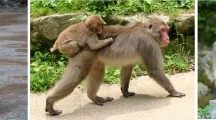Abstract
This report contains detailed data on the sexual behavior of the 60 sexually mature females of the Arashiyama West troop of Japanese macaques.
The study group was a natural troop transported intact in 1972 to a ranch in South Texas. Since transplantation, the monkeys have been free to roam and feed within a 42.2 ha enclosure. Analysis of data collected on the 140 monkeys that composed the troop during the 1973–74 and 1974–75 breeding seasons revealed: (1) Female-male mounting is an important aspect of Japanese macaque sexual behavior; (2) All females had preferred partners and most avoided both heterosexual and homosexual interactions with close kin; (3) Pubescent and adult females exhibit different patterns of sexual behavior; (4) Pubescent and adult females were affected somewhat differently by the transportation from Japan to their current home in South Texas. These behavioral patterns and their implications are discussed.
Similar content being viewed by others
References
Altmann, J., 1974. Observational study of behavior: Sampling methods.Behaviour, 48–49: 227–261.
Carpenter, C. R., 1942. Sexual behavior of free-ranging rhesus monkeys.J. Comp. Psy., 33: 113–141.
Chevalier-Skolnikoff, S., 1974. Male-female, female-female and male-male sexual behavior in the stumptail monkey, with special attention to the female orgasm.Arch. Sex. Behav., 3: 95–116.
Clark, T. &T. Mano, 1975. Transplantation and adaptation of a troop of Japanese macaques to a Texas brushland habitat. In:Contemporary Primatology,S. Kondo,M. Kawai, &A. Ehara (eds.), S. Karger, Basel, pp. 358–361.
DeVore, I., 1965. Male dominance and mating behavior in baboons. In:Sex and Behavior,F. Beach, (ed.), John Wiley & Sons, Inc., New York.
Eaton, G. G., 1973. Social and endocrine determinants of sexual behavior in simian and prosimian females.IV Int. Congr. Primat., Karger, 2: 20–35.
Enomoto, T., 1974. The sexual behavior of Japanese monkeys.J. Hum. Evol., 3: 351–372.
Hanby, J., 1972. The sociosexual nature of mounting and related behaviors in a confined troop of Japanese macaques. A dissertation, Univ. of Oregon.
Kaufman, J., 1965. A three-year study of mating behavior in a free-ranging band of rhesus monkeys.Ecology, 46(4): 500–512.
Loy, J., 1971. Estrous behavior of free-ranging rhesus monkeys (Macaca mulatta).Primates, 12: 1–31.
Owens, N. W., 1976. The development of sociosexual behavior in free-living baboons.Behaviour, 57, Parts 3–4: 241–259.
Saayman, G. S., 1970. Endocrine factors and behavior in old-world monkeys.S. Af. J. Sci., 212: 65–66.
Tokuda, K., 1961–62. A study on the sexual behavior in the Japanese monkey troop.Primates, 3(2): 1–40.
Wolfe, L. D., 1978. Age and sexual behavior of Japanese monkeys.Arch. Sex. Behav., 7(1): 55–68.
Zumpe, D. &R. P. Michael, 1968. The clutching reaction and orgasm in the female rhesus monkey (Macaca mulatta).J. Endocrin., 40: 117–123.
Author information
Authors and Affiliations
Additional information
The study was partially supported by PHS Biomedical Science Grant 50-262-1112.
About this article
Cite this article
Wolfe, L. Behavioral patterns of estrous females of the Arashiyama West troop of Japanese macaques (Macaca fuscata). Primates 20, 525–534 (1979). https://doi.org/10.1007/BF02373434
Received:
Accepted:
Issue Date:
DOI: https://doi.org/10.1007/BF02373434




